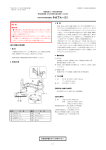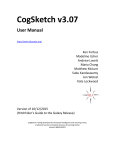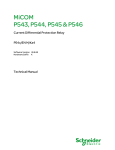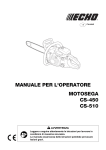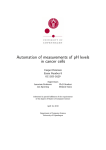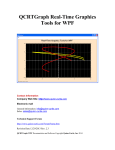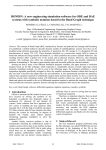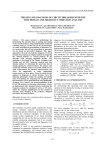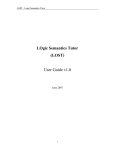Download Real-Time Self-Explanatory Simulation
Transcript
Real-Time Self-Explanatory Simulation
Franz G. Amador and Adam Finkelstein and Daniel S . Weld*
Department of Computer Science and Engineering, FR-35
University of Washington
Seattle, Washington 98195
franz, adam, weldLacs .washington.edu
Abstract
We present Pika, an implemented self-explanatory
simulator that is more than 5000 times faster than
SimGen Mk2 [Forbus and Falkenhainer, 1992], the
previous state of the art. Like SimGen, Pika automatically prepares and runs a numeric simulation
of a physical device specified as a particular instantiation of a general domain theory, and it is
capable of explaining its reasoning and the simulated behavior . Unlike SimGen, Pika's modeling language allows arbitrary algebraic and differential equations with no prespecified causal direction ; Pika infers the appropriate causality and
solves the equations as necessary to prepare for
numeric integration .
Introduction
Science and engineering have used numeric simulation
productively for years. Simulation programs, however, have been laboriously hand-crafted, intricate, and
difficult to understand and change . There has been
much recent work on automating their construction
(e.g. [Yang, 1992, Rosenberg and Karnopp, 1983,
Abelson and Sussman, 1987, Palmer and Cremer,
1992]) . To this, the Qualitative Physics community
has contributed the idea of a self-explanatory simulator
[Forbus and Falkenhainer, 1990, Forbus and Falkenhainer, 1992]. When using such a system, a person
need only specify the basic entities, quantities, and
equations governing the system to be simulated . From
these, the program automatically prepares and runs a
numeric simulation . It also keeps a record of its reasoning so it can explain the simulated behavior.
Such a simulator has three primary advantages [Forbus and Falkenhainer, 1990] .
*Many thanks to the members of the E3 project, especially Mike Salisbury and Dorothy Neville. Pandu Nayak
kindly provided Common Lisp causal ordering code. Elisha Sacks and Eric Boesch kindly provided the RungeKutta numeric integration code. This research was funded
in part by National Science Foundation Grant IRI-8957302,
Office of Naval Research Grant 90-J-1904, and the Xerox
corporation .
" Improved automation : Because the user specifies
the simulated system declaratively using equations,
creating and modifying simulations is much easier .
" Improved self-monitoring: The simulator can
analyze the equations to produce checks that detect
problems with the simulation, such as numerical instability .
" Better explanations:
Because the simulator
records the deductions needed to prepare the simulation, it can generate custom English-language or
graphical explanations for the simulated behavior .
Such explanations assist debugging the simulated
equations, and they can form the core of an automated tutor that allows the user to explore and learn
about the behavior of a simulated system .
The first and third of these properties are of
particular interest to the Electronic Encyclopedia/Exploratorium (E 3 ) project at the University of
Washington .
We are constructing a program via
which the user may interact with simulated versions
of various engineered artifacts to learn how they work
[Amador et al., 1993] . The user can perturb the environment of the device to see how it reacts and even
modify the device itself as it is "operating," all the
while receiving English or graphical explanations for its
behavior. Thus a central part of the E3 program is effectively a combined CAD system and self-explanatory
simulator .
Unfortunately, existing self-explanatory simulators,
namely the SimGen Mkl and SimGen Mk2 programs
(Forbus and Falkenhainer, 1990, Forbus and Falkenhainer, 1992], do not meet our needs .
" Too slow: Both compile the equation model of an
artifact into a custom program that simulates it .
While SimGen Mk2 is much faster than SimGen
Mkl, this compilation process still takes much too
long to allow prompt response to user manipulations
of the artifact model . For example, SimGen Mk2 requires 4 hours to compile a simulator for a model of
9 containers and 12 pipes [Forbus and Falkenhainer,
1992] .
" Restrictive modeling language: As with their
predecessor Qualitative Process Theory [Forbus,
1984], the SimGen programs require equations to
be written as uni-directional influences . Thus the
flow of causality and information through the model
must be chosen by the modeler and remains fixed .
We claim it is easier and more natural to describe
a model using ordinary non-directional equations .
(See "Equations" below .)
In this paper we present Pikal , an implemented selfexplanatory simulator which overcomes these limitations . Its first, unoptimized implementation prepares
the above SimGen Mk2 example simulation in under
3 seconds-more than 5000 times faster . Furthermore,
the modeling language is based upon ordinary differential and algebraic equations, which Pika automatically
manipulates as necessary to simulate the model .
The modeling language
As with the SimGen programs, our modeling language
(known as the Quantified Modeling Language (QML))
derives from the Qualitative Process Theory [Forbus,
1984) . The user defines a model in two parts. The
physics that apply to the device are defined in a domain theory, which is general and can be reused when
modeling different devices . This theory is instantiated
according to a scenario description, which specifies a
particular device for simulation . For example, a domain theory might describe the various types of electrical components while a corresponding scenario description would specify a particular circuit .
QML has two distinguishing features : a simplified
modeling language and non-directional equations .
Model Fragments
Qualitative Process Theory's entity, process, and view
definitions are replaced by model fragments (MFs), of
which there are two kinds . Unquantified MFs (similar
to QP Theory's entities) are instantiated explicitly in
the scenario description . Quantified MFs (similar to
QP Theory's processes and views) are instantiated automatically by the system when their preconditions are
met, and their instances are likewise destroyed when
those preconditions no longer hold. Here, for example,
is a simplistic characterization of boiling .
(define-MF boiling (?fluid)
(preconditions
(instance-of Liquid ?fluid)
(>_ (temperature ?fluid)
(boiling-temperature ?fluid)))
(effects
(dyn-infl (mass ?fluid)
(heat-absorption-rate ?fluid)
(latent-heat ?fluid))))))
written using terminology first advocated by Woods
[Woods, 1991] . Pika sums all dynamic influences upon
a quantity to form an equation that constrains its
derivative . Thus if boiling is the only active MF, the
derivative of mass is constrained to be equal to the ratio of absorption rate and latent heat of vaporization .
However, if an MF encoding fluid flow into the container were active then that, influence would be added
to the sum constraining the derivative . Algebraic influences (alg-inf1) are similar-they specify an implicit
summation constraining the influenced quantity itself.
Equations
Pika treats all QML equations as non-directional constraints. This follows standard scientific practice better than do QP Theory's one-directional influences.
Scientists express almost all physical laws as constraint
equations . Ohm's Law (V = IR), for example, makes
no commitment as to which variables are dependent
and which are independent . In different contexts, such
an equation can determine the value of any of its variables . If a resistor MF containing an Ohm's-Law equation appears in a model in which it is connected to a
constant-voltage source, Pika will use the equation to
find the current through the resistor . If the resistor
is instead connected to a constant-current source, the
equation determines the voltage drop across it.
Non-directional equation constraints make model
writing much easier . The modeler can write the ideal
gas law (PV = nRT) in its familiar form, without having to decide how it will be used in future
simulations . Even QML's "influences", specify nondirectional equations . The dynamic. influence in the
boiling MF above provides the modularity of QP
Theory's direct influences without making any commitment to causal direction . Such modular specification of non-directional summation equations provides the modeler with considerable expressive power.
For example, to encode Kirchhoff's current rule for
electrical nodes, the modeler need simply include
the equation (= (net-current ?self) 0) in a Node
MF, together with (alg-infl (net-current ?node)
(current ?terminal)) in an MF that will be instantiated for each connected node and terminal . From
this, Pika will create an equation for each node that
constrains the sum of the currents of its connected terminals to be zero. Note that the "influenced" quantity
remains constant; causality flows among the "influencing" terminal currents as appropriate . This use of influences is impossible in QP Theory.
The simulation algorithm
Unlike the SimGen programs (known collectively hereafter as "SimGen"), Pika does not compile the artifact
model before simulating it . However, it does compile
the domain theory once after it is written or changed .
Pika's domain theory compiler translates each model
The dyn-infl (dynamic influence) is a nondirectional version of a QP-theory "direct influence"
l A pika (pronounced pee-kuh) is a small mammal that
lives in alpine rockpiles.
12
Since Pika does no such compile-time analysis, it
must test all quantified MF preconditions at runtime
to determine the active set. For each MF it queries the
knowledge base for all argument bindings that meet the
non-quantitative preconditions (e.g. the instance-of
test in the boiling example) . In the worst case, this is
exponential in the number of MF arguments, but their
number is under the modeler's control and is always
small .'- Pika then tests the quantitative preconditions
of these candidate MF activations, which requires time
linear in the size of the quantitative expressions .
fragment into a set of functions that speed simulation : a model fragment's preconditions are compiled
into functions that query the knowledge base to find
bindings for the MF's arguments, that test whether the
quantitative part of the preconditions is satisfied, and
that generate numeric integration bounding conditions
that halt integration when those quantitative preconditions cease to be satisfied (or become satisfied, given
that the non-quantitative preconditions are met) . The
model fragment's effects are compiled into functions
that assert those effects when the MF is activated and
that retract them when it is deactivated .
This compilation requires little time (less than the
LISP compiler requires to compile the resulting code) .
Furthermore, one need not suffer even this small cost
except when the domain theory changes, which happens quite infrequently compared with changes to the
model being simulated .
Since Pika is still being integrated with the E3 user
interface [Salisbury and Borning, 1993], its current implementation runs in a "batch" manner. Pika takes
as input the compiled domain theory, the scenario description, and a period of time for which to simulate.
It simulates for the requested time, recording its reasoning and the device's behavior, and then stops to
answer the user's questions .
Pika's simulation algorithm is as follows :
Numeric integration
SimGen uses custom-generated evolver procedures
(which use Euler's method) to do numeric integration
and state transition procedures to detect transitions in
qualitative state . Because Pika does not compile the
model, it must instead use a general-purpose numeric
integrator . Its current implementation uses a fourthorder Runge-Kutta integrator with adaptive step-size
control [Press et al ., 1986], which, at a given accuracy,
is much faster than Euler's method .3
In addition to the simulation equations, initial quantity values, and integration limit, the integrator also
takes as input a set of integration bounds . Each bound
is an expression and an interval ; if the expression's
value ever leaves the interval, the integrator halts (at
the time step immediately before the bound is violated) . Pika supplies bounds representing the quantitative preconditions of all currently active model
fragments (known as deactivation bounds) and other
bounds representing the quantitative preconditions of
all MFs that are inactive only because of their quantitative preconditions (activation bounds) .
Instantiate unquantified MFs from scenario description
Repeat until time bound reached
Instantiate and deinstantiate quantified MFs based
upon world state
Causally order the equations
Solve the equations for the quantities they determine
Create integration bounds from MF preconditions
Numerically integrate until a bound is violated
Equation manipulation
All the equations in a SimGen model are written either
as direct influences or as qualitative proportionalities
(indirect influences) . SimGen converts these into numeric integration equations by 1) summing the direct
influences upon each quantity's derivative, 2) sorting
the indirect influences into a graph (causal ordering)
such that all quantities are determined, and 3) converting the influence subgraph that. determines each
quantity into an algebraic equation via a table (known
as the math library) . Since this table contains a different equation for each possible combination of influences
upon each quantity, any given qualitative proportionality can "mean" different things in different contexts .
This arrangement implies a "two-tiered" process of
quantitative model construction : the domain theory is
instantiated based upon MF preconditions to produce
Pika's algorithm differs from SimGen's in three important ways: MF activation, numeric integration, and
equation manipulation .
Model fragment activation
Both SimGen programs use an assumption-based truth
maintenance system (ATMS) [de Kleer, 1986] to perform substantial analysis during model compilation .
SimGen MkI generates a total envisionment of the
model's qualitative state space, which is computationally infeasible for large models. SimGen Mk2 reduces
this cost by finding only the "local states" in which
each MF is active . This analysis allows them to reduce
the run-time checking needed to determine changes in
the set of active MFs . If the simulation is in a qualitative state from which there is only one possible transition, then the simulator need check only the limit hypothesis corresponding to that transition, and it can
switch directly to the set of active MFs determined
during compilation to be active in the next qualitative
state. This speeds simulation, but it exacts an enormous cost during compilation .
'Note that SimGen must also confront this exponential
when instantiating MFs into the ATMS.
3 It is important to emphasize that Pika's performance
advantage over SimGen is not due to the underlying integration technology-the important speed-up is in simulation preparation .
13
a qualitative model, and then the math library is instantiated based upon the qualitative model influences
to produce the quantitative model . This structure may
make writing some kinds of models easier, but it requires the modeler to write every equation twice: once
qualitatively for the domain theory, and once quantitatively for the math library. It also sacrifices possible
modularity. Influences allow the modeler to specify
qualitative equations in pieces that are automatically
assembled by SimGen ; however, the modeler must fully
specify all possible quantitative model equations .
With Pika, the modeler specifies the domain theory using equations which Pika automatically combines and symbolically manipulates as needed to form
the quantitative model . QML thus effectively collapses
SimGen's two-tiered structure into one, allowing modular specification of quantitative model equations .
Pika must convert the model's non-directional equations into the following directional form expected by
the Runge-Kutta integrator :
dX,
Y1=9i(X1, . ., X , t)
t)
dt = fi(X1,
Q : Summarize the simulated behavior .
A : At time 0, heat started flowing from STOVE to
CAN-OF-WATER .
At time 55 .96147, the temperature of CAN-OFWATER reached 100 .0, and it started boiling .
At time 55 .969383, a gas appeared in CAN-OFWATER .
At time 95 .961464, the liquid in CAN-OF-WATER
boiled away, and it stopped boiling .
At time 165 .31618, the pressure of CAN-OF-WATER
exceeded 150 .0, and the container exploded .
Q : What is the value of (TEMPERATURE CAN-OF-WATER)
at time 40?
A : (TEMPERATURE CAN-OF-WATER) is 82 .10323 at
time 40 .
Q : How is (TEMPERATURE CAN-OF-WATER) changing?
A : (TEMPERATURE CAN-OF-WATER) is increasing
at time 40 .
Q : What happens next?
A : At time 55 .96147, the temperature of CAN-OFWATER reached 100 .0, and it started boiling .
X" t)
Ym =9 .".(X1, . . .,Xn,t)
are
the
state
variable
used by the inteThe X's
grator to advance time ; the Y's are all other variables calculated from the state variables . Pika classifies any quantity that has a derivative (generally
due to a dyn-inf1) as a state variable. It rearranges the equations into the above form by first using
a causal ordering routine [Iwasaki and Simon, 1986,
Serrano and Gossard, 1987] to find an order in which
the equations can be evaluated so as to determine values for all quantities ; this ordering may include sets of
simultaneous e nations . Pika then uses Mathematica's
[Wolfram, 1988 Reduce function to solve each equation for the quantity it determines (unless it is already
in "solved" form, i.e. (= determined-quantity expression)) . Mathematica also solves any simultaneity for
the quantities it determines . However, since causal ordering abstracts equations to sets of quantities, it can
falsely group non-independent equations as simultaneities. Here we rely upon the fact that Reduce, if it
cannot find a solution, will reformulate the equations,
discarding non-independent ones, so that another attempt at causal ordering will not make the same mistake . This process repeats until the causal ordering
contains no simultaneities .
The modeler may denote some quantities as constants . Non-constant quantities retain their previous
values if they are not determinable from the state variables . Implementing these semantics requires that the
equation-directionalizing process make several passes .
First, all constants are marked as exogenous, and
causal ordering and equation solving discover which
quantities are determinable from them . Next, those
state variables that remain undetermined (usually all
of them) are marked as exogenous, and the algorithm
d
Figure 1 : Example of explanation generation . Queries
are translations from a specialized query language; answers are actual program output .
runs again . Lastly, all remaining, undetermined quantities are given their previous values and treated as
constants under the current set of equations . A feature of this algorithm is that the modeler can force
a state variable to be constant during one operating
region while allowing it to vary during another .
Explanations
By keeping a record of its equation manipulations,
the history of model fragment activations and deactivations, and the data returned by numeric integration, Pika can answer the class of questions answerable
by SimGen Mk2 . This includes summarizing so-farsimulated behavior in qualitative terms, reporting the
equation that determines the value of any quantity at
any simulated time, and reporting the value of a quantity at any simulated time. It objects if the quantity
does not exist at the requested time. Because it does no
global envisioning, Pika (like SimGen Mk2) cannot answer some questions answerable by SimGen Mkl, such
as summarizing currently unsimulated future behavior
and describing alternative behaviors . See figure 1 for
an example.
Implementation status
PIKA is fully implemented. It is written in Allegro
Common Lisp and uses the LOOM knowledge representation system (version 1 .4.1) [Brill, 1991], the Mathematica symbolic math system (version 2.0) [Wolfram,
14
Test
SimGen Mk2 :
9 cont & 12 pipe
36 cont & 60 pipe
2-run RC ladder
5-run RC ladder
Exploding can
Prep
2 .7s
34s
4.9s
38s
0.5s
Total
3 .1s
38s
5.1s
38s
1.8s
RK %
6
Mma %
6
1.5
0 .0006
5
stants, state variables, and value persistence without
having to repeatedly run a causal-ordering procedure .
For example, every quantity has an associated lowstrength equation that sets it equal to its most recent
simulated value . SkyBlue includes the constraint representing this equation in the causal ordering only if
the quantity is not otherwise determined .
SkyBlue also allows one-way constraints, which
Pika2 uses to represent the fact that the derivative of
a state variable is numerically integrated to determine
the state variable's next value, but not vice versa . This
allows a more accurate definition of a state variable
than Pika uses: a state variable is a quantity having a
derivative that can be causally determined if the quantity is assumed to be a state variable (and hence exogenous to each time step) . This definition better reflects
the cyclic nature of numeric integration, and SkyBlue
will use a one-way constraint between derivative and
possible state variable only when the definition is satisfied .
Pika2's initial simulation-preparation times are
about the same as Pika's, but unfortunately it is not
yet stable enough for timings demonstrating the value
of incremental constraint management.
0
0
70
87
40
Figure 2: Timing data (Sun SPARCstation IPX) .
1988], and a Runge-Kutta numeric integration package
that is written in C [Press et al ., 1986] . See figure 2
for timing data.
The "prep" column is what we are comparing to
SimGen's model-compilation time; it gives the time
needed to prepare each model for simulation. This
table demonstrates PIKA's speed and scalability for
models that do not produce large sets of simultaneous equations . However, the 2-rung and 5-rung "RC
ladder" electrical circuit tests require solving sets of 21
and 51 simultaneous equations, respectively, and suffer
accordingly.
Second prototype
Related work
One way to reduce the impact of equation manipulation is to avoid redoing it when unnecessary . Pika regenerates the simulation equations "from scratch" every time the set of active MFs changes . We have reimplemented Pika (as Pika2) using SkyBlue [Sannella,
1992], a hierarchical constraint manager . SkyBlue effectively maintains a causal-ordering graph which can
be updated incrementally as MFs activate and deactivate . Only those equations whose causal direction
changes (or which form new simultaneities) must Pika2
resolve . Also, Pika2 caches solutions of individual
equations, though not of simultaneities .
SkyBlue offers other advantages over "traditional"
causal ordering methods . Each constraint (a set of
variables) has a specified strength . SkyBlue builds the
causal-ordering graph from the highest-strength, consistent set of constraints, leaving some lower-strength
constraints unused if necessary.
Pika2 uses this
strength hierarchy to implement the semantics of con-
An important inspiration for much work in selfexplanatory simulation was the STEAMER project
[Holland ei al., 1984], which produced an impressive
interactive simulator/tutor for a naval propulsion system, though all the simulations and explanations were
hand-crafted in advance .
Many people have worked on easing the construction of fast, accurate numeric simulations . The iSMILE and MISIM systems [Yang and Yang, 1989,
Yang, 1992], for example, provide tools for constructing a variety of electrical and optical circuit simulations . The modeler must define new components using a subset of FORTRAN, however, and the systems
do no equation manipulation . The ENPORT program
[Rosenberg and Karnopp, 1983] generates numeric simulations from the more declarative bond-graph system representation, and the Dynamicist's Workbench
project [Abelson and Sussman, 1987] generates simulations from equation models . None of these systems,
however, allow changes in the equations during simulation .
Besides SimGen, the system closest in spirit to our
own is SimLab [Palmer and Cremer, 1992], which allows a model-fragment-like specification of equationbased models that it symbolically manipulates to prodace numeric simulations. SimLab does not, however,
allow .changes in the equations during simulation, nor
does it generate explanations .
We note that the "How Things Work" project at
Stanford [Fikes et al., 1992] is addressing issues similar
to those those tackled by Pika; however, the Stanford
work is too preliminary to discuss extensively .
4 Elapsed time spent before the first numeric integration.
STotal simulation elapsed time. The container/pipe and
RC ladder tests were simulated until "quiescence", i.e.
until all quantities had completed 99% of their possible
change.
r'Percent of total time spent doing numeric integration .
7Percent of total time spent solving equations .
8 0ur implementation of the example described in [Forbus and Falkenhainer, 1992] .
'The SimGen Mk2 example container grid quadrupled .
l0 Each "rung" of an "RC ladder" is a capacitor with
some initial voltage in series with a resistor . All rungs are
connected in parallel.
"See figure 1.
15
K . Forbus and B . Falkenhainer . Self-Explanatory
Simulations : An integration of qualitative and quantitative knowledge . In Proceedings of AAAI-90, pages
380-387,1990.
K . Forbus and B. Falkenhainer . Self-Explanatory
Simulations : Scaling Up to Large Models . In Proceedings of AAAI-92, page To Appear, 1992 .
K . Forbus . Qualitative Process Theory . Artificial
Intelligence, 24, December 1984 . Reprinted in [Weld
and de Kleer, 1989] .
J . Holland, E . Hutchins, and L . Weitzman.
STEAMER : An interactive inspectable simulationbased training system . AI Magazine, Summer 1984.
Y. Iwasaki and H. Simon . Causality In Device Behavior . Artificial Intelligence, 29(1) :3-32, July 1986.
Reprinted in [Weld and de Kleer, 1989] .
R.S. Palmer and J .F . Cremer . SimLab: Automatically Creating Physical Systems Simulators. In ASME
DSC-Vol . /,1, November 1992.
W . Press, B. Flannery, S . Teukolsky, and W . Vetterling, editors . Numerical Recipes . Cambridge University Press, Cambridge, England, 1986.
R.C. Rosenberg and D .C. Karnopp . Introduction to
Physical System Dynamics . McGraw Hill, New York,
1983.
M . Salisbury and A. Borning. A User Interface for
the Electronic Encyclopedia Exploratorium . In Pro-
Future work
Pika is fast, but it isn't quite fast enough to drive a
truly interactive simulation for the E3 project . We estimate that we need another factor of ten for practical
use and are working on several ways to speed it up .
Pika currently uses LOOM [Brill, 1991] for its knowledge base, but it uses almost none of LOOM's inferencing power. Switching to LOOM's CLOS subset,
or abandoning LOOM altogether, should significantly
speed Pika .
Using Mathematica to solve equations dramatically
slows Pika; solving a set of a dozen linear simultaneous equations can take several seconds . Pika prepares
the SimGen Mk2 example in under 3 seconds partly
because that model requires no equation solving . Using a dedicated linear-equation solver instead (when
possible) should help.
Conclusions
We have presented Pika, a self-explanatory simulator 5000 times faster than SimGen Mk2, the previous state of the art. Pika also provides a more natural and more expressive modeling language based upon
non-directional algebraic and differential equation constraints. Pika and the SimGen programs represent
points along a continuum : SimGen Mk1 does an enormous amount of model analysis prior to simulation,
SimGen Mk2 does less, and Pika does almost none.
Pika must therefore pay a greater cost when changing
the model during simulation . The highly interactive
nature of simulation in the E3 project demands such
an architecture . However, the performance results suggest that Pika's strategy may work well for other applications .
ceedings of the 1993 International Workshop on Intelligent User Interfaces, Orlando, FL, January 1993 .
M . Sannella. The SkyBlue Constraint Solver . Technical Report 92-07-02, Department, of Computer Science and Engineering, University of Washington, December 1992.
D . Serrano and D .C. Gossard . Constraint Management in Conceptual Design . In Knowledge Based
References
Expert Systems in" Engineering: Planning and Design, pages 211-224 . Computational Mechanics Pub-
H . Abelson and G .J . Sussman . The Dynamicist's
Workbench : I Automatic Preparation of Numerical
Experiments. AI Memo 955, MIT AI Lab, May 1987.
Franz G . Amador, Deborah Berman, Alan Borning,
Tony DeRose, Adam Finkelstein, Dorothy Neville,
David Notkin, David Salesin, Mike Salisbury, Joe
Sherman, Ying Sun, Daniel S. Weld, and Georges
Winkenbach. Electronic "How Things Work" Articles: Two Early Prototypes . IEEE Transactions on
Knowledge and Data Engineering, To Appear 1993 .
D . Brill . LOOM Reference Manual . USC-ISI, 4353
Park Terrace Drive, Westlake Village, CA 91361, version 1 .4 edition, August 1991 .
J. de Kleer . An Assumption-based Truth Maintenance System . Artificial Intelligence, 28, 1986 .
R. Fikes, T. Gruber, and I. Iwasaki . The Stanford
How Things Work Project . In Working Notes of the
lications, 1987 .
D . Weld and J . de Kleer, editors . Readings in Qualitative Reasoning about Physical Systems. Morgan Kaufmann, San Mateo, CA, August 1989.
S . Wolfram . Mathematica: A System for Doing
Methem.atics by Computer. Addison-Wesley, Redwood City, CA, 1988.
E. Woods . The Hybrid Phenomena Theory . In Proceedings of the 5th intenational workshop on qualitative reasoning, pages 71-76, May 1991 .
AT . Yang and S .M . Yang . iSMILE : A Novel Circuit
Simulation Program with Emphasis on New Device
Model Development . In Proceedings of ACM/IEEE
1989 Design Automation Conference, pages 630-633,
1989 .
A .T. Yang . MISIM User's Manual. Department
of Electrical Engineering, University of Washington,
1992 .
AAAI Fall Symposium on Design from Physical Principles, pages 88-91, October 1992.
16
Appendix :
QML
Grammar
DOMAIN DESCRIPTION : := {DEFINE PREDICATE * DEFINEMODELFRAGMENT+}+
DEFINEPREDICATE : := (define-predicate (PREDI.CATENAME VARIABLE+))
DEFINE MODELFRAGMENT
DEFINEQUANTIFIEDMF
DEFINE EXTEND ERMF
DEFINE UNQUANTIFIEDMF
DEFINE QUANTIFIED MF : := (define-MF MFNAME (MFARG + ) PRECONDITIONS
EFFECTS)
DEFINE EXTEND ERMF : := (define-MF MFNAME (?self) PRECONDITIONS
EFFECTS)
; ; Extends the description of any entity meeting its preconditions .
DEFINE UNQUANTIFIED MF : := (define-MF MFNAME () EFFECTS)
MFNAME : := NAME
MFARG : := VARIABLE
PRECONDITIONS
PRECONDITION
; ; excluding "?self"
(preconditions PRECONDITION*)
MEMBERSHIPTEST
ENTITY SAMENESSTEST
QUANTITATIVETEST
I PREDICATETEST
MEMBERSHIPTEST : := (instance-of MFNAME PRECENTITYPATH)
ENTITYSAMENESSTEST
(same PRECENTITYPATH PRECENTITYPATH)
(different PRECENTITYPATH PRECENTITYPATH)
QUANTITATIVE TEST : := (COMPARATOR PRECEXPRESSION PRECEXPRESSION)
PREDICATETEST : := (PREDICATENAME PRECENTITY PATH + )
PRECENTITYPATH : := ENTITYPATH
; ; excludes '?self" if QuantifaedMF
PRECQUANTITYPATH : := QUANTITYPATH ; ; excludes "?self" if QuantifaedMF
EFFECTS : := (effects EFFECT * )
EFFECT
INHERITANCE
DEFINEQUANTITY
EQUATION
I ALGEBRAIC INFLUENCE
i DYNAMIC INFLUENCE
ASSERT PREDICATION
RETRACT PREDICATION
DEFINESLOT
CREATE SLOT FILLER
FILLSLOT
CONSISTENCYTEST
I REPORTQUANTITIES
I SETDEFAULTINITIALVALUE
INHERITANCE : :_ (inherits-from UNQUANTIFIEDMFNAME ENTITYPATH)
; ; of an UnquantifiedMF
UNQUANTIFIEDMFNAME : := MFNAME
DEFINEQUANTITY : := (define-quantity QUANTITYPATH
[ :persistent
:history
:parameter]
[ :default-initial-value]
[DEFAULTINITIALVALUE] )
; ; Defaults to :persistent . :History is optional hint to state-variable finder.
DEFAULT INITIALVALUE : := NUMBER
EQUATION : := (= EXPRESSION EXPRESSION)
ALGEBRAIC INFLUENCE : := (alg-infl QUANTITYPATH EXPRESSION)
DYNAMIC INFLUENCE : := (dyn-infl QUANTITYPATH EXPRESSION)
ASSERT PREDICATION : := (assert (PREDICATENAME ENTITYPATH + ) )
;; Persists until explicitly retracted .
RETRACT PREDICATION : := (retract (PREDICATENAME ENTITYPATH + ))
DEFINESLOT : := (define-slot (SLOTNAME ENTITYPATH))
CREATESLOTFILLER : := (create-slot-filler UNQUANTIFIEDMFNAME SLOTREFERENCE)
FILLSLOT : := (fill-slot SLOTREFERENCE ENTITYPATH)
CONSISTENCYTEST : := (ensure (COMPARATOR EXPRESSION EXPRESSION))
; ; Simulation halts if test ever fails .
REPORT QUANTITIES : := (report QUANTITYPATH + )
; ; Simulator returns values of "report" quantities (but saves all quantity values
;; for later explanation) .
SET DEFAULT IN ITIALVALUE : := (default-initial -value QUANTITYPATH NUMBER)
; ; Used to override default initial values of inherited quantities .
ENTITYPATH
I
ENTITYNAME
VARIABLE
SLOTREFERENCE
INSTANCEOF
CREATEANONYMOUSINSTANCE
ENTITYNAME : := NAME
VARIABLE : := ?NAME ?self
;; Using "?self" in the effects of a QuantifiedMF creates its instance entity .
SLOTREFERENCE : := (SLOTNAME ENTITYPATH)
INSTANCEOF : := (instance-of QUANTIFIED MFNAME ENTITYPATH+)
;; Returns the instance of QuantifiedMFName whose args are bound to the EntityPaths .
CREATEANONYMOUSINSTANCE : := (create-instance UNQUANTIFIEDMFNAME)
I
QUANTIFIED MFNAME : := MFNAME
SLOTNAME : := NAME
COMPARATOR : :=
< I <= I = I /= I
; ; of a QuantifiedMF
>=
EXPRESSION
NUMBER
QUANTITYPATH
(STANDARD FUNCTION EXPRESSION)
(UNARYARITHMETICOP EXPRESSION)
(BINARYARITHMETICOP EXPRESSION EXPRESSION)
(NARYARITHMETICOP EXPRESSION+)
STANDARD FUNCTION
expt exp log sqrt sin cos tan
I
sinh
I/
UNARYARITHMETIC OP : := BINARYARITHMETICOP : := +
NARYARITHMETICOP : := +
QUANTITYPATH
QUANTITYNAME
I
I
I
cosh
I
I
tanh
I
I
asin
I
I
acos
(QUANTITYNAME ENTITYPATH + )
NAME
I
I
I
atan
time
NAME : := valid LISP identifier not starting with "?"
SCENARIO DESCRIPTION
I
CREATE NAMED INSTANCE
ASSERTFACT
RETRACTFACT
SETCURRENTVALUE} +
CREATENAMEDINSTANCE : := (create-instance UNQUANTIFIEDMFNAME ENTITYNAME)
ASSERTFACT : := (assert-fact (PREDICATENAME GROUND ENTITY PATH+))
RETRACTFACT : := (retract-fact (PREDICATENAME GROUND ENTITYPATH+))
SETCURRENTVALUE : := (current-value GROUND QUANTITY PATH NUMBER)
GROUND ENTITY PATH : := ENTITYPATH
GROUND QUANTITYPATH : := QUANTITYPATH
; ; that has no variables
; ; that has no variables









